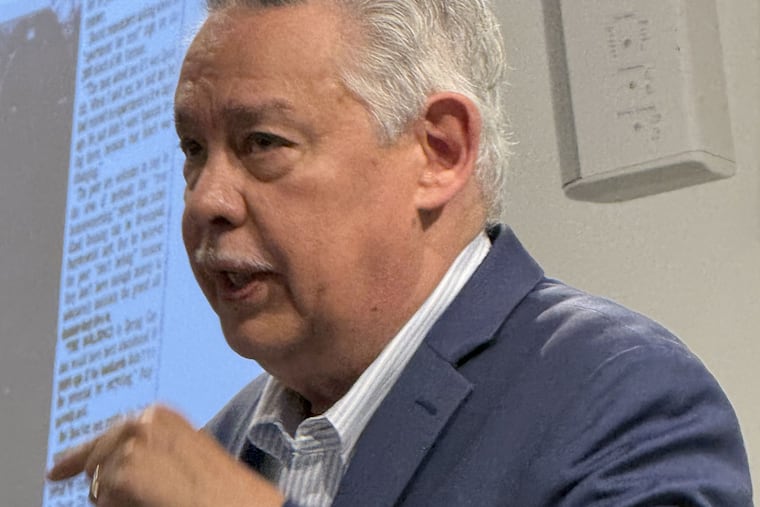Juan González, cohost of ‘Democracy Now!,’ spoke about the migration of Puerto Ricans to Pennsylvania
His lecture at the Historical Society of Pennsylvania was part of an exhibit on Puerto Rican stories open through Oct. 11.

You may have seen Juan González delivering sober news about the world on the television program Democracy Now!
But years before González was cohosting the show with Amy Goodman, he was marching down Broad Street in Philadelphia with John F. Street and Milton Street — during their housing activism days — trying to secure deeds for families who squatted in vacant and abandoned homes.
The problem for González was that he was also a reporter and, later, a columnist for the Philadelphia Daily News. His bosses yelled at him and told him he couldn’t participate in protests and then write about them, González told an audience at the Historical Society of Pennsylvania on Thursday.
“Then I asked them why was the rewrite editor, who is Catholic and the leader of a Catholic organization, in charge of covering the pope’s visit,” González said, referring to Pope John Paul II’s 1979 visit to Philadelphia.
Protesting was not new to González, now in his 70s. He helped found the Young Lords in East Harlem and was a veteran of the 1968 Columbia University student protests.
After leaving the Daily News, González went on to become a columnist for the New York Daily News before joining Democracy Now!
The award-winning investigative journalist, who is a two-time George Polk Award winner, now lives in Chicago, where he is a senior research fellow at the Great Cities Institute at the University of Illinois.
González returned to Philadelphia to give a lecture on the economic and military forces that led to the migration of Puerto Ricans from the U.S. territory island to Pennsylvania over the years.
The lecture, “From Puerto Rico to Pennsylvania: History, Challenges, and Amor Boricua,” was part of the Historical Society’s current exhibition, “HSP 200 + Taller 50: Uncovering and Preserving Puerto Rican Stories,” on display now through Oct. 11.
The exhibit is being presented in partnership with Taller Puertorriqueño to celebrate the society’s 200th anniversary this year and Taller’s 50th anniversary.
“Uncovering and Preserving Puerto Rican Stories” investigates themes of migration and community, culture and identity, and how memory is preserved. The exhibit also reexamines Batiendo La Olla, an oral history project that Taller Puertorriqueño produced in the 1970s to document the Puerto Rican experience in Philadelphia.
Waves of migration from Puerto Rico to Pennsylvania
González said that migration from the island to Pennsylvania began increasing dramatically about 2015 because of economic forces when companies began pulling their manufacturing operations from the island and taking them to other countries where the labor was cheaper. After the Cold War ended, the United States began shutting down military bases, which also contributed to job losses.
González also talked about organizing with the Puerto Rican Alliance, which helped 150 families get deeds to homes they had once squatted. Among the protests to accomplish that, the alliance first occupied the federal Housing and Urban Development offices near Independence Hall. Then, when authorities threatened to call the police, they moved to Independence Hall to hold a sit-in there.
At another protest, on the night before the 1980 Democratic primary in Pennsylvania, when the late Sen. Ted Kennedy was challenging President Jimmy Carter for the nomination, Puerto Rican activists held a sit-in at Carter’s campaign headquarters on Chestnut Street near Broad.
González said the Carter staff sent for the top Puerto Rican official in the White House and for the late U.S. Rep. Bill Gray III to negotiate. He said Gray persuaded the protesters — who included the late Juan Ramos and Angel Ortiz, who both were later elected to City Council— to leave. The 150 families did get the deeds to their homes.
Another organization that González once led was the National Congress of Puerto Rican Rights, where he worked with fellow activist Juan R. Sánchez, who was organizing mushroom workers in Chester County. Sánchez is now a federal judge in the Eastern District of Pennsylvania.
Erikka Goslin, the interim executive director at Taller, said that Taller was excited to partner with the Historical Society, because the current exhibit “centers the stories, voices, and history of Puerto Ricans and Latinos in Philadelphia.”
She said that González “added an invaluable perspective” on that history, “with incredible personal anecdotes told firsthand. He reminds us that we at Taller are an arts and culture organization rooted in social justice, place-making, and community work.”
HSP 200 + Taller 50: Uncovering and Preserving Puerto Rican Stories is on display at HSP during library hours, 10 a.m. to 4 p.m. Tuesday, Thursday, and Friday, and 1 to 7 p.m. Wednesday, at 1300 Locust St., Philadelphia.